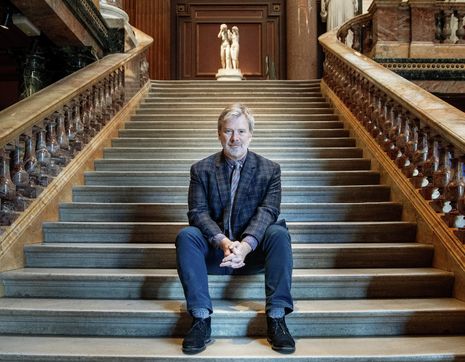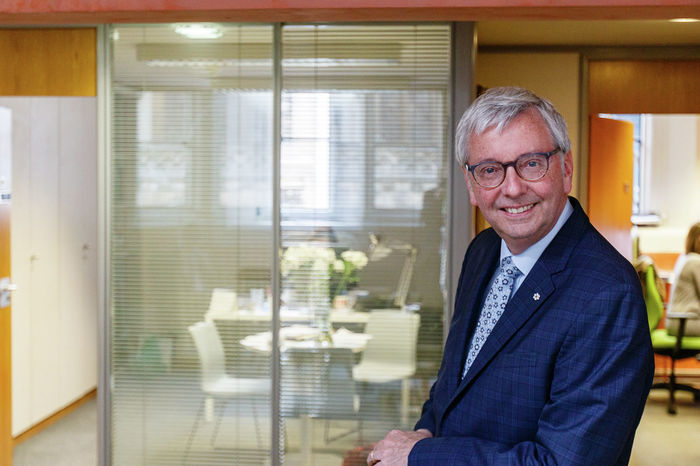Director Luke Syson wants to re-examine the Fitzwilliam Museum’s collections and legacy
“What is our social, our civic, our societal role? How can we make ourselves more indispensable to more people’s lives?”

A week has passed since the third reopening of the Fitzwilliam Museum and as I walk down Trumpington street a crowd of people are lining up to go inside. Past the spiked railings and the stony lion guardians, I turn right down a tree-covered road which takes me up to the Fitz’s offices in Grove Lodge where I’m meeting with Luke Syson, Director of the Fitzwilliam Museum.
In contrast to the towering neoclassical façade of the museum, Grove Lodge is reassuringly unintimidating. Syson welcomes me into what I imagine was once a dining room and sits across from me at a broad wooden table. Outside, a performance of As You Like It is taking place and the occasional line slips in through a crack in the window.
I’m struck by how normal our meeting feels but suspect that for Syson this restored normality is particularly pronounced. Having been appointed Director in February 2019, he has spent the majority of his tenure overseeing a museum closed to the public.
The COVID era brought its own set of challenges for Syson, but the Sisyphean task of responding to the events of this past year is far from over. As the museum sector shakes itself out of its stupor, it re-emerges onto a cultural landscape irreversibly altered by the Black Lives Matter movement. If before, inaction on anti-racism could be passed off as complacency, continued lethargy can only be considered an act of complicity.
As an institution, the Fitzwilliam has its fair share of untangling to do. For starters, it is one of the largest museums in the UK, housing over 500,000 objects spanning four millennia of human creation. Notably however, it has no collections from the Global South. These works reside instead in the Museum of Archaeology and Anthropology.
“[The Fitzwilliam] has collections of material that were considered [historically] as belonging to the category of ‘art’, as belonging to civilisations that were deemed to be part of the chain of being that led to our own glorious civilisation.” Syson says this with more than a pinch of irony. “Despite the fact that European artists were annexing or citing artwork from Africa, it wasn’t regarded as being part of the narrative the Fitzwilliam wanted to tell.”
“A cityscape should feel inclusive, it should feel democratic, and it should feel aspirational”
This is a narrative that Syson is unwilling to perpetuate. “It was a white, European, male-dominated history of art,” he says. “And even if I thought that was acceptable, the rest of the world doesn’t and I don’t either.”
Syson received a BA in Art History from the Courtauld Institute, an education which he describes as being “exclusively Western”. He says, however, that “shaking this off was a very quick process” and describes how his interests were “informed early on by the consciousness of working in museums that looked at the whole world”.
The challenge for Syson, having previously worked at museums with a global scope, is to come back to a collection which was built up in a way that militates against the telling of more inclusive and global narratives. Having inherited a collection that willfully excluded so many artistic traditions, how might Syson present a global history of art?
The first step, Syson tells me, is to re-interpret Fitzwilliam’s existing material. He cites, as an example, a medallion inscribed with Josiah Wedgewood’s ‘am I not a man and a brother’ slogan. The image, showing “a person of colour in a subservient pose”, is universally recognisable. It is an image which “has its legacy today in racist attitudes” that remain all too prevalent.
“However, it was also an object that persuaded an awful lot of the white population at that moment, who were prepared to think of slavery as something that happened far away, [to think of it] as something that affected them immediately, emotionally and politically.”
Some objects, Syson admits, are “purely bad and need to be dealt with”, but on the whole objects do not fit neatly into a ‘good’ vs. ‘bad’ binary. Instead Syson stresses the idea that “every object is complex in terms of its history, and that [objects] can provide quite simple pathways to this complexity.” Handled with care, an object such as the Wedgewood medallion “can raise consciousness, can build awareness, can foster protest”.
With the image of a toppled Edward Colston still fresh in my mind, I wonder how Syson feels about the removal of such artwork. “One thing to say is that the strength of feeling that has given rise to actual physical removal is completely understandable given that for much too long people like me working in institutions didn’t do enough.
“[Art] loses its energy in some profound way when there aren’t people to look at it”
“I instinctively favour an idea of keeping things in play because my worry is that if you remove them those histories get forgotten. But I also worry very much if the promises to explain are hollow or not carried out; that seems to me to be very worrying indeed […] So I’m slightly agnostic on this issue. If people want to remove things, if that seems like the right thing to do, then I’m comfortable with that broadly.
“What I would really like us to be doing, is to make sure that our public spaces are populated in the right way with works of art that we are commissioning and creating now… So we are creating an environment, in Cambridge say, where you don’t walk into colleges and see no people of colour, no women: we’re actually representing people.
“A cityscape should feel inclusive, it should feel democratic, and it should feel aspirational… I think that there are ways in which we can proclaim our values in the streets, in niches, in chapels in places now which to some degree, show that we have overcome the legacies that these earlier objects have imposed on us. That is what I would be wanting to do.”
Hesitantly, I ask Syson whether he has had to interrogate his own position as a white man within this discourse. He begins equally cautiously – “I’m a gay white man and I’m a white man who has partial Jewish ancestry [...] I would be very careful to say that this is not about equivalence; it is not about the same experiences, but it does mean that when you’re looking to expand your narrative you’re conscious of your own lack of representation which gives you some form of empathy.
“But yes is the answer, fundamentally yes. I’ll probably get things wrong every now and then and I’m sure I do. But the times we’re in, and the role that I’m in, make me acutely aware of the dangers of making assumptions based exclusively on my own experience.”
I push Syson further on this topic: are we going to see members of marginalised communities in Cambridge actively involved in the commissioning and acquisition of new works at the Fitzwilliam? “There is a part of me, which as a traditional museum creator, thinks, ‘golly giving over agency in that way to people outside the museum feels very uncomfortable’ […] But ultimately it is a good suggestion.”
Everything Syson and I have spoken about to this point fundamentally concerns the interaction of art and people. It is striking, then, that this heightened public discourse has been taking place at a time of collective distance between society and its artworks. For over a year, lovers of art were only able to experience works through the glitchy prism of the digital divide.
Syson is no stranger to visiting galleries that are closed to the public – this is, he says, “one of the great privileges of [his] profession”. He did not, however, look forward to his occasional visits to the Fitzwilliam during its closure. “A closed-up building, with at that point no clear expectation of when people will return, is very different from that stolen hour before you know you’re going to be sharing it again with lovers of art, people who have come to feel and to think. Art”, he says “loses its energy in some profound way when there aren’t people to look at it.”
Though efforts were made to transpose parts of the Fitz’s collections into the virtual realm, this provides an alternative, but not substitute, way of seeing art. “I still think [...] that there is no substitute for standing in front of a work of art, engaging with it in real life, in real time, in the flesh. That’s when you find yourself with tears in your eyes, that’s when you get a shiver up your spine, that’s when you are moved and ideally you’re starting to think.”
As the Fitzwilliam begins to welcome visitors once again, Syson seeks to address a number of questions as Director – “what is our social, our civic, our societal role? How can we make ourselves more indispensable to more people’s lives?” After our conversation, I feel confident that Syson intends on taking on these challenges with urgency and with force.
 News / SU stops offering student discounts8 January 2026
News / SU stops offering student discounts8 January 2026 Comment / Plastic pubs: the problem with Cambridge alehouses 5 January 2026
Comment / Plastic pubs: the problem with Cambridge alehouses 5 January 2026 Science / New year, new room, new you8 January 2026
Science / New year, new room, new you8 January 2026 Comment / What happened to men at Cambridge?31 December 2025
Comment / What happened to men at Cambridge?31 December 2025 News / Uni-linked firms rank among Cambridgeshire’s largest7 January 2026
News / Uni-linked firms rank among Cambridgeshire’s largest7 January 2026










